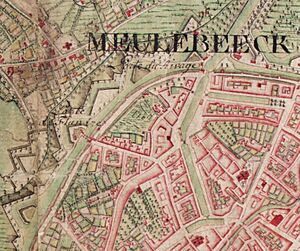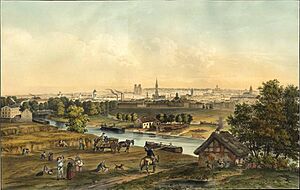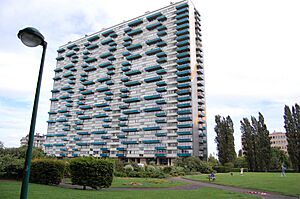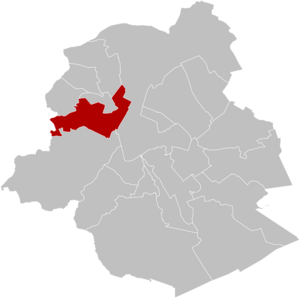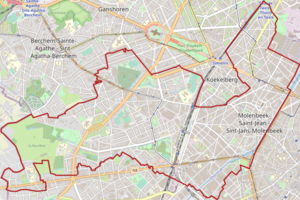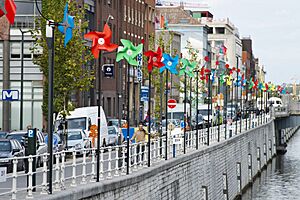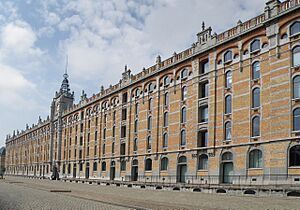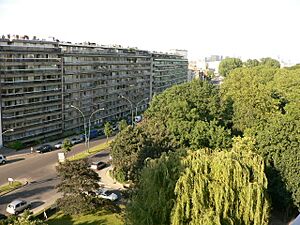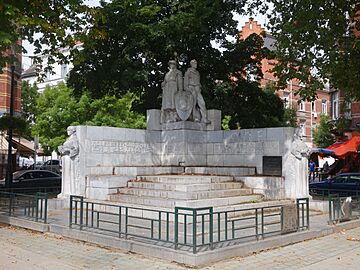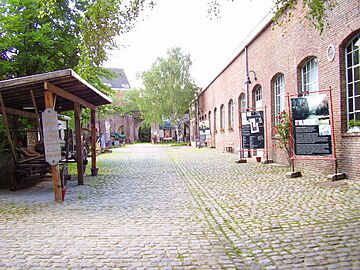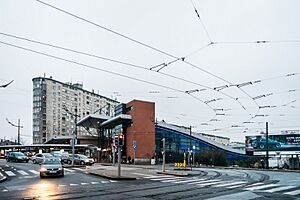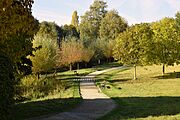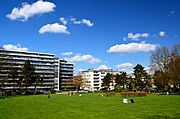Molenbeek-Saint-Jean facts for kids
Quick facts for kids
Molenbeek-Saint-Jean
|
|||
|---|---|---|---|
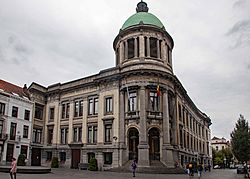
Molenbeek's Municipal Hall seen from the Place Communale/Gemeenteplein
|
|||
|
|||
| Country | Belgium | ||
| Community | Flemish Community French Community |
||
| Region | Brussels | ||
| Arrondissement | Brussels-Capital | ||
| Area | |||
| • Total | 5.89 km2 (2.27 sq mi) | ||
| Population
(2018-01-01)Lua error in Module:Wd at line 1575: attempt to index field 'wikibase' (a nil value).
|
|||
| • Total | Lua error in Module:Wd at line 1,575: attempt to index field 'wikibase' (a nil value). | ||
| Postal codes |
1080
|
||
| Area codes | 02 | ||
| Website | molenbeek.irisnet.be/fr molenbeek.irisnet.be/nl |
||
Molenbeek-Saint-Jean (in French) or Sint-Jans-Molenbeek (in Dutch) is one of the 19 towns that make up the Brussels-Capital Region in Belgium. People often just call it Molenbeek. It's located in the western part of Brussels. A canal called the Brussels–Charleroi Canal separates it from the main City of Brussels.
Molenbeek started as a small village in the Middle Ages. It grew a lot during the Industrial Revolution in the 1800s. Many factories and businesses opened there. After World War II, some industries closed down. This led to changes in the town. From the 1950s, many people from other countries moved to Molenbeek. This made it a very multicultural place. In recent years, Molenbeek has been working on improving its neighborhoods and community life.
As of 2022, Molenbeek has about 97,697 people living there. It covers an area of 6.02 square kilometers (about 2.3 square miles). This means it's a very busy place, with many people living close together. The higher parts of Molenbeek are greener and have fewer buildings.
Contents
- Understanding the Name: Molenbeek
- A Look Back: Molenbeek's History
- Exploring Molenbeek: Geography
- Neighborhoods of Molenbeek
- What to See: Main Sights in Molenbeek
- People of Molenbeek: Demographics
- Sports and Education in Molenbeek
- Getting Around: Transportation in Molenbeek
- Green Spaces and Parks
- Famous People from Molenbeek
- Molenbeek's International Connections
- See also
Understanding the Name: Molenbeek
What Does "Molenbeek" Mean?
The name Molenbeek comes from two Dutch words. Molen means "mill," and beek means "brook" or "stream." So, Molenbeek literally means "Millbrook." This name is common for streams in Belgium and the Netherlands.
The name first referred to the stream that flowed through the village. Around the year 985, people started using Molenbeek to describe the village itself. The longer names, Saint-Jean (French) or Sint-Jans (Dutch), mean "Saint John." This refers to Saint John the Baptist, who is the patron saint of the local church. However, most people today just say Molenbeek.
How Do You Say Molenbeek?
In French, Molenbeek-Saint-Jean is pronounced like "mol-uhn-bek san zhan." In Dutch, Sint-Jans-Molenbeek sounds like "sint-yahns moh-luhm-bake." In both languages, the "beek" part sounds like "bake" in English. People from Molenbeek are called Molenbeekois in French and Molenbeekenaars in Dutch.
A Look Back: Molenbeek's History
From Village to Town: Early Days
As far back as the 800s, there was a church in Molenbeek dedicated to Saint John the Baptist. This church's area was much larger than it is today. In the 12th century, a small chapel was built, which later became the St. Catherine's Church in Brussels. The first official mention of Molenbeek was in 1174. This was in a document from Pope Alexander III.

In the early Middle Ages, Molenbeek was famous for a special spring. It was linked to Gertrude of Nivelles, a saint. Many pilgrims visited it. There was also a tradition for people with epilepsy. On St. John's Day (June 24), they would take part in a dancing procession. They believed crossing a bridge over the Molenbeek stream without touching the ground would help them. A painting by Pieter Brueghel the Younger from 1592 shows this procession.
Molenbeek became part of Brussels in the 1200s. This meant the farming village lost much of its land. The St. John's Church was even taken apart in 1578 during a time of religious change. It was later rebuilt. Molenbeek stayed mostly a rural village until the 1700s.
The Industrial Revolution and Growth
At the end of the 1700s, the Industrial Revolution brought new life to Molenbeek. Trade and factories made the town rich again. In 1795, Molenbeek became an independent town once more. It started to grow with new neighborhoods like Faubourg Saint-Martin and Faubourg de Flandre.
In the early 1800s, hundreds of people worked in Molenbeek's chemical and textile factories. By 1829, there were 50 companies. The opening of the Brussels–Charleroi Canal in 1832 was a big deal. It made it easier to transport coal. This helped industries like foundries and metalworking grow. Many workers moved to Molenbeek, first from other parts of Belgium and France, then from Southern Europe, and later from Eastern Europe and Africa.
Molenbeek kept growing throughout the 1800s. Living conditions became crowded, especially near the canal. People started calling Molenbeek the Little Manchester or the Belgian Manchester. This was because Manchester in England was a leading city in the Industrial Revolution. On May 5, 1835, Molenbeek was the starting point for the first passenger train in mainland Europe. Later, Brussels took over some of Molenbeek's industrial area near the canal.
Molenbeek in the 1900s
By the early 1900s, Molenbeek was a busy suburb with many working-class people. New housing developments, including "garden cities" like the Cité Diongre, were built. The Church of St. John the Baptist was rebuilt in the 1930s in the Art Deco style. However, after World War I and World War II, industries started to decline.
After the war, many original Belgian working-class families moved out of lower Molenbeek. They moved to newer suburbs of Brussels when they could afford it. New immigrant families moved into these older parts of town. This led to the diverse community we see today. In the 1960s, new homes were built in the western, more rural parts of Molenbeek. This expansion stopped in the 1990s, leaving some green areas like the Scheutbos.
Many old industrial buildings near the canal and railway have been changed. They are now used for homes or other community purposes. For example, the Fonderie, a former metal factory, is now Brussels' Museum of Industry and Labour. It tells the story of Molenbeek's industrial past. The extension of the metro in the 1970s and 1980s also brought changes to the town. Despite all these changes, Molenbeek has kept its unique character.
Molenbeek in the 2000s
In some areas, poverty has affected Molenbeek's neighborhoods and social life. This has led to efforts to improve the community. Various local programs are working to help the poorer areas. Today, the local economy is changing. The administrative sector, like government offices, is important. Large companies like KBC Bank and Delhaize are also present.
There have been challenges in improving the town. In 2011, a company called BBDO almost left Molenbeek. They said their staff had faced many attacks. This raised questions about safety and local leadership. However, crime rates later decreased, and the company decided to stay.
Molenbeek has faced challenges related to safety and community well-being. The Belgian police have conducted investigations in the area. These efforts aimed to improve safety and address issues in the community. The investigations looked at many organizations and individuals. They found some involved in crime and others with links to concerning activities. These operations help ensure the safety and security of the community.
Exploring Molenbeek: Geography
Where is Molenbeek Located?
Molenbeek is in the middle of Belgium. It's about 110 kilometers (68 miles) from the Belgian coast. It's also about 45 kilometers (28 miles) south of Antwerp and 50 kilometers (31 miles) north of Charleroi. Molenbeek is one of the westernmost towns in the Brussels-Capital Region. The Brussels–Charleroi Canal runs along its eastern border. Molenbeek is 6.02 square kilometers (2.32 square miles) in size. This makes it one of the smaller towns in the region. It borders other Brussels towns like Anderlecht, Berchem-Sainte-Agathe, Jette, and Koekelberg. It also borders the Flemish town of Dilbeek.
Molenbeek's Weather
Molenbeek, like the rest of Brussels, has an oceanic climate. This means it has warm summers and cool winters. The nearby Atlantic Ocean brings marine air. This makes the climate mild. On average, it rains about 135 days a year. Snow doesn't fall very often, only about 24 days a year. Sometimes, there are strong thunderstorms in the summer.
The official weather station for Belgium is in Uccle, south of Brussels. The weather records there are similar to what you would find in Molenbeek.
| Climate data for Brussels-Capital Region (1981–2010) | |||||||||||||
|---|---|---|---|---|---|---|---|---|---|---|---|---|---|
| Month | Jan | Feb | Mar | Apr | May | Jun | Jul | Aug | Sep | Oct | Nov | Dec | Year |
| Mean daily maximum °C (°F) | 5.9 (42.6) |
6.8 (44.2) |
10.5 (50.9) |
14.2 (57.6) |
18.3 (64.9) |
20.9 (69.6) |
23.3 (73.9) |
23.0 (73.4) |
19.5 (67.1) |
15.1 (59.2) |
9.8 (49.6) |
6.3 (43.3) |
14.5 (58.1) |
| Daily mean °C (°F) | 3.2 (37.8) |
3.5 (38.3) |
6.5 (43.7) |
9.5 (49.1) |
13.5 (56.3) |
16.1 (61.0) |
18.4 (65.1) |
18.0 (64.4) |
14.9 (58.8) |
11.1 (52.0) |
6.8 (44.2) |
3.8 (38.8) |
10.4 (50.7) |
| Mean daily minimum °C (°F) | 0.7 (33.3) |
0.6 (33.1) |
2.9 (37.2) |
4.9 (40.8) |
8.7 (47.7) |
11.5 (52.7) |
13.6 (56.5) |
13.0 (55.4) |
10.5 (50.9) |
7.5 (45.5) |
4.5 (40.1) |
1.5 (34.7) |
6.7 (44.1) |
| Average precipitation mm (inches) | 75.2 (2.96) |
61.6 (2.43) |
69.5 (2.74) |
51.0 (2.01) |
65.1 (2.56) |
72.1 (2.84) |
73.6 (2.90) |
76.8 (3.02) |
69.6 (2.74) |
75.0 (2.95) |
77.0 (3.03) |
81.4 (3.20) |
848.0 (33.39) |
| Average precipitation days (≥ 1 mm) | 12.8 | 11.1 | 12.7 | 9.9 | 11.3 | 10.5 | 10.1 | 10.1 | 10.4 | 11.2 | 12.6 | 13.0 | 135.6 |
| Mean monthly sunshine hours | 58 | 75 | 119 | 168 | 199 | 193 | 205 | 194 | 143 | 117 | 65 | 47 | 1,583 |
| Source: KMI/IRM | |||||||||||||
Neighborhoods of Molenbeek
Molenbeek has two main parts: a lower area and an upper area. The lower area is next to the canal. It has many working-class families, often with Moroccan roots. The upper area is closer to Brussels' second ring road. It has newer buildings and is mostly home to middle-class families.
Molenbeek's neighborhoods are very diverse. They mix larger districts with smaller residential and former industrial areas. The area along the canal is currently being revitalized. This is part of a plan for the Brussels-Capital Region.
Lower Molenbeek: Busy Areas
The Historical Center
The historical center is the main part of Molenbeek. It grew during the Industrial Revolution along the Brussels–Charleroi Canal. Today, this area faces social and economic challenges. The Municipal Hall is located here, on the Place Communale (Municipal Square).
Duchesse (Quatre-vents)
This neighborhood is south of the historical center. It is focused around the Place de la Duchesse de Brabant. This square was created in 1847. The Church of St. Barbara was built here in 1869 for Catholic worship. Several streets also meet at this square.
Heyvaert
Heyvaert is in the southeast of Molenbeek. It's near the main slaughterhouse in Brussels, in Anderlecht. It's also along the Charleroi Canal. This area is part of the larger Cureghem/Kuregem district. It's named after the Rue Heyvaert street.
Maritime
The Maritime district is in the north of Molenbeek. It developed around 1900 because of the Port of Brussels. This area has a mix of customs agencies, handling businesses, and homes. It has always been a diverse neighborhood, with workers and different social classes living there.
Upper Molenbeek: Residential Areas
Karreveld
Karreveld is in the north of upper Molenbeek. It's named after the old Karreveld Castle and its park, which is about 3 hectares (7.4 acres). Today, it's mostly a residential area. It's located between the Avenue de la Liberté, the Chaussée de Gand, and the railway.
Korenbeek
Korenbeek is in the northeast of Molenbeek. It's home to the Molenbeek Cemetery. This cemetery opened in 1864. It replaced the old church cemetery, which had become too small.
Machtens (Marie-José)
This district is in the upper part of Molenbeek. It's in the valley of the Maalbeek (or Molenbeek) stream. In 1920, the town bought this area. They turned part of it into two parks: Albert Park and Marie-José Park. These parks are named after King Albert I and his daughter, Princess Marie-José.
Osseghem/Ossegem
Osseghem or Ossegem is in the center of upper Molenbeek. It's west of the historical center. It used to be a small rural village. The name comes from old Germanic words meaning "residence of the people of Odso." An old road, now the Rue d'Osseghem, connected this village to Molenbeek and Brussels.
Scheutbos (Mettewie)
The Scheutbos (or Scheutbosch) is in the far west of Molenbeek. It's near the Boulevard Louis Mettewie. This is Molenbeek's main "green" area. It includes the protected natural site also called Scheutbos.
What to See: Main Sights in Molenbeek
Molenbeek-Saint-Jean has many interesting cultural and architectural places. Here are some of the main attractions:
- The Municipal Hall of Molenbeek: This building is on the Place Communale. It was designed in an eclectic style and opened in 1889.
- The Church of St. John the Baptist: This Catholic church was built in Art Deco style in 1931–32. It has been a protected monument since 1984.
- The Church of St. Remigius: Located on the Boulevard du Jubilé, this neo-Gothic building was finished in 1907.
- The Church of St. Barbara: This is another neo-Gothic church on the Place de la Duchesse de Brabant. It was completed in 1894 and protected in 1998.
- Molenbeek Cemetery: This cemetery has impressive monuments, including old burial galleries and a columbarium built in 1880.
- Karreveld Castle and its park: This castle is used for cultural events and town council meetings. In the early 1900s, it was a birthplace of Belgian Cinema. A film studio was built here, and animals like bears and camels were used in movies. Since 1999, the castle hosts the Festival Bruxellons!, a theater festival.
- The Municipal Museum of Molenbeek (MoMuse): This museum is in the beautiful building of the Academy of Drawing and Visual Arts.
- The Vaartkapoen statue: You can find this statue on the Place Sainctelette.
Many old industrial buildings have also been restored. They are now used for homes and community activities. Some examples include:
- The Fonderie: This was a former metal factory. Now it's Brussels' Museum of Industry and Labour. It teaches about Molenbeek's industrial and social history.
- The Raffinerie: This used to be a sugar refinery. Now it's a center for culture and modern dance.
- The Bottelarij: This was a bottling plant. It temporarily housed the Royal Flemish Theatre during renovations.
- The Millennium Iconoclast Museum of Art (MIMA): This museum opened in 2016. It focuses on modern and urban art. It's in the old buildings of the Belle-Vue brewery. It's the first museum of its kind in Europe.
- The buildings of Tour & Taxis: These impressive former goods station buildings are being turned into homes and businesses.
- Brussels' Circus School: This school is located in the buildings of Tour & Taxis.
-
A World War I memorial on the Boulevard du Jubilé.
People of Molenbeek: Demographics
How Molenbeek's Population Has Changed
Historically, Molenbeek had a small population. In 1707, only 690 people lived there. By the early 1800s, it was still fewer than 2,000. But after the Industrial Revolution, the population grew a lot. It reached its highest point of 72,783 people in 1910. Then, it slowly decreased until 1961, when it was 63,528. After that, it started to grow rapidly again.
As of 2020, Molenbeek had 97,979 residents. The area is 6.02 square kilometers (2.32 square miles). This means there are about 16,314 people per square kilometer. The population is quite young, with an average age of 35. Nearly 29% of residents are under 18. Fewer than 12% are over 65. The population has grown by 24.5% in the last ten years.
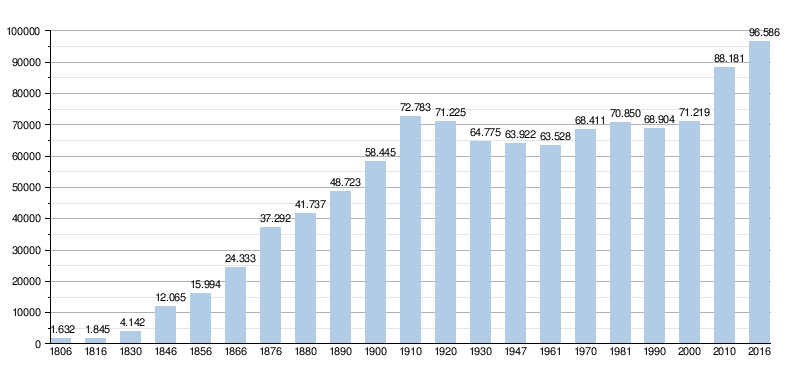
- Sources: INS: 1806 to 1981= census; 1990 and later = population on 1 January
Diverse Population Groups
| 5,960 | |
| 4,242 | |
| 2,255 | |
| 1,956 | |
| 1,759 | |
| 1,666 | |
| 1,040 |
Molenbeek is known for its diverse population. Many residents have roots in other countries. The largest group of foreign residents in 2020 was from Morocco. Other large groups came from Romania, Spain, France, Italy, Syria, and Poland.
In 2016, the mayor of Molenbeek, Françoise Schepmans, noted that many foreign residents were from the same background and lived in the same area. This was seen as a challenge. Also, nearly 40% of young people in Molenbeek were unemployed at that time. Molenbeek is part of an area in Brussels sometimes called the "poor croissant."
As of 2023, if you look at where people's parents were born, about 69% of Molenbeek's population has recent heritage from non-European countries. Most of these are from Morocco and Syria. About 17% are from other European countries. Only about 13% of the population is native Belgian. Many permanent residents from outside the EU have become Belgian citizens.
| Group of origin | Year | |
|---|---|---|
| 2023 | ||
| Number | % | |
| Belgians with Belgian background | 13,083 | 13.31% |
| Belgians with foreign background | 56,630 | 57.63% |
| Neighbouring country | 1,873 | 1.91% |
| EU27 (excluding neighbouring country) | 3,338 | 3.4% |
| Outside EU 27 | 51,419 | 52.32% |
| Non-Belgians | 28,557 | 29.06% |
| Neighbouring country | 2,301 | 2.34% |
| EU27 (excluding neighbouring country) | 9,709 | 9.88% |
| Outside EU 27 | 16,547 | 16.84% |
| Total | 98,270 | 100% |
Sports and Education in Molenbeek
Sports Activities
In Molenbeek, like the rest of Brussels, sports are managed by different communities. The French-speaking community has an administration for physical education and sports (ADEPS). The Dutch-speaking community has Sport Vlaanderen. These groups help support different sports clubs and federations.
Football in Molenbeek
Molenbeek has a well-known football club called Racing White Daring Molenbeek, or RWDM. It was very popular until it closed in 2002. A new club, R.W.D.M. Brussels F.C., took its place and played in Belgium's first division. It also closed in 2013. But since 2023, a new version of the club, RWDM47, is back in the first division. Their home stadium is the Edmond Machtens Stadium.
Other Sports
Molenbeek is also home to the Royal Daring Hockey Club Molenbeek. This is a field hockey club.
Education for Young People
Most students in Molenbeek, aged 3 to 18, attend schools organized by either the French-speaking Community or the Flemish Community.
Primary Schools
There are 17 French-language primary schools and six Dutch-language primary schools in Molenbeek.
Secondary Schools
- Athénée royal Serge Creuz (French-speaking)
- Athaneum Toverfluit (Dutch-speaking)
Getting Around: Transportation in Molenbeek
Roads and Highways
The Boulevard Léopold II in northern Molenbeek is a large road that runs east to west. It leads to the National Basilica of the Sacred Heart in Koekelberg. Other important roads in Molenbeek include the Chaussée de Gand, the Boulevard Edmond Machtens, and the Chaussée de Ninove. The Boulevard Louis Mettewie runs north to south.
Public Transportation
Molenbeek is well-connected by Brussels' metro system. You can find metro stations like Comte de Flandre/Graaf van Vlaanderen, Étangs Noirs/Zwarte Vijvers, Osseghem/Ossegem, Belgica, Beekkant, Gare de l'Ouest/Weststation (Brussels-West Station), and Ribaucourt. Brussels-West and Beekkant stations connect to all metro lines. They are important hubs for transport in western Brussels. Brussels-West will also become more important with the new Brussels Regional Express Network (RER/GEN), which will connect Brussels to nearby towns. Molenbeek also has a good network of bus and tram services. These connect the town to other parts of the region. You can also find Villo! public bicycle stations in Molenbeek.
Waterways
Molenbeek is located on a major waterway route in Belgium. This route connects Antwerp, Brussels, and Charleroi. It uses the maritime Scheldt river, the Maritime Canal, and the Brussels–Charleroi Canal.
Green Spaces and Parks
Molenbeek has several green spaces and parks where people can relax and enjoy nature:
- Scheutbos Park: This is a regional nature park that covers about 6 hectares (15 acres).
- Semi-natural site of the Scheutbos: This is a protected natural area of about 44 hectares (109 acres).
- Karreveld Park: This park is about 3 hectares (7.4 acres).
- Marie-José Park: This park covers about 6 hectares (15 acres).
- Albert Park
- Muses' Park
- Hauwaert Park
- Bonnevie Park
- Fonderie Park
Famous People from Molenbeek
- Montasser AlDe'emeh (born 1989), a Belgian-Palestinian researcher.
- Richard Beauthier (1913–1999), a politician and senator, was born here.
- Norbert Benoit (1910–1993), a filmmaker.
- Louis Bertrand (1856–1943), a politician and author.
- Ado Chale (born 1928), an artist.
- Serge Creuz (1924–1996), a painter.
- Jean De Middeleer (1908–1986), a musician.
- Eugène Demolder (1862–1919), a writer.
- Joseph Diongre (1878–1963), a modernist architect.
- Alfred Dubois (1898–1949), a professor and violinist.
- Alexis Dumont (1877–1962), an architect, was born here.
- Ferdinand Elbers (1862–1943), a mechanic, trade unionist, and politician.
- Hendrik Fayat (1906–1997), a politician.
- Eugene Hins (1839–1923), a founder of a newspaper and leader of a freethinking movement.
- Marcel Josz (1899–1984), an actor, was born here.
- Eugène Laermans (1864–1940), a painter and engraver.
- Daniel Leyniers, Esq. (1881–1957), a politician and senator, was born here.
- Marka, Serge Van Laeken (born 1961), a singer, songwriter, and filmmaker.
- Pierre-Joseph Meeûs-Vandermaelen (1793–1873), an industrialist and politician.
- Henry Meuwis (1870-1935), a painter.
- Georges Mogin, also known as Norge (1898–1990), a poet.
- Philippe Moureaux (1939–2018), a politician, senator, and former mayor of Molenbeek.
- Michel Mourlon (1845–1915), a geologist and paleontologist.
- Jean Muno (1924–1988), a writer.
- Zeynep Sever (born 1989), Miss Belgium 2008.
- Robert Schuiten (1912–1997), an architect and painter.
- Jean Stampe (1889–1978), a war pilot and aircraft manufacturer.
- Eric Struelens (born 1969), a professional basketball player.
- Herman Teirlinck (1879–1967), a writer.
- Pierre Tetar van Elven (1828–1908), a painter.
- Toots Thielemans (1922–2016), a jazz artist.
- Henri Joseph Thomas (1878–1972), a painter.
- Pierre Van Humbeeck (1829–1890), a politician and Minister of Education.
- Leon Vanderkindere (1842–1906), a historian and professor, was born here.
- Philippe Vandermaelen (1795–1869), a geographer and cartographer.
- Franky Vercauteren (born 1956), a football personality.
- Firmin Verhevick (1874–1962), a painter, was born here.
- Thierry Zéno (1950–2017), an author-filmmaker.
Molenbeek's International Connections
Twin Towns
Molenbeek has special connections with other towns around the world. These are called twin towns or sister cities.
 Oujda, Morocco
Oujda, Morocco Levallois-Perret, France
Levallois-Perret, France
See also
 In Spanish: Molenbeek-Saint-Jean para niños
In Spanish: Molenbeek-Saint-Jean para niños





